Shopify store credit is a valuable tool for online retailers to boost customer satisfaction and retention. It allows sellers to issue credits to customers, which can be used for future purchases, making the shopping experience smoother and more enjoyable for both parties. This guide will show you how to manually issue store credit and how to use third-party apps for a more efficient process.
What is Shopify Store Credit?
Shopify Store Credit is a feature that allows merchants to issue credit to customers, which can be used as a payment method in their Shopify store. This credit functions similarly to a gift card or a discount, providing customers with a balance they can apply toward products and services offered by the store. Here are some key aspects of Shopify Store Credit:
- Customer Retention: Encourages repeat purchases.
- Flexibility: Issuable for returns, refunds, or promotions.
- Management: Track and adjust balances in Shopify admin.
- Integration: Works with loyalty programs and promotions.
- Customer Experience: Easy alternative to refunds, enhancing satisfaction.

Benefits of Using Store Credit
Using store credit offers numerous advantages for both merchants and customers. Here are the key benefits:
Promotes Customer Loyalty
It also promotes customer loyalty by giving customers a reason to return and feel valued. For instance, loyal customers receiving store credit as a reward are encouraged to continue shopping at your store.
Encourages Repeat Purchases
Store credit encourages repeat purchases, increasing customer loyalty. For instance, a customer returning an item and receiving store credit is likely to buy a new item from your store, fostering loyalty.
Improves Cash Flow for Merchants
For merchants, it improves cash flow by keeping money within the business. Shopify reports that businesses using store credit see a 15% improvement in cash flow. For example, issuing $100 in store credit instead of a refund keeps that money in the business.
Simplifies Refund Process
Store credit simplifies the refund process and enhances customer satisfaction. Customers appreciate the flexibility of store credit, as seen when they receive credit for a return and use it later for future purchases.
Increases Average Order Value
Additionally, customers using store credit often spend more than their credit amount, increasing average order values. For example, a customer with $50 in store credit may buy items totaling $70, paying the extra $20 out-of-pocket.
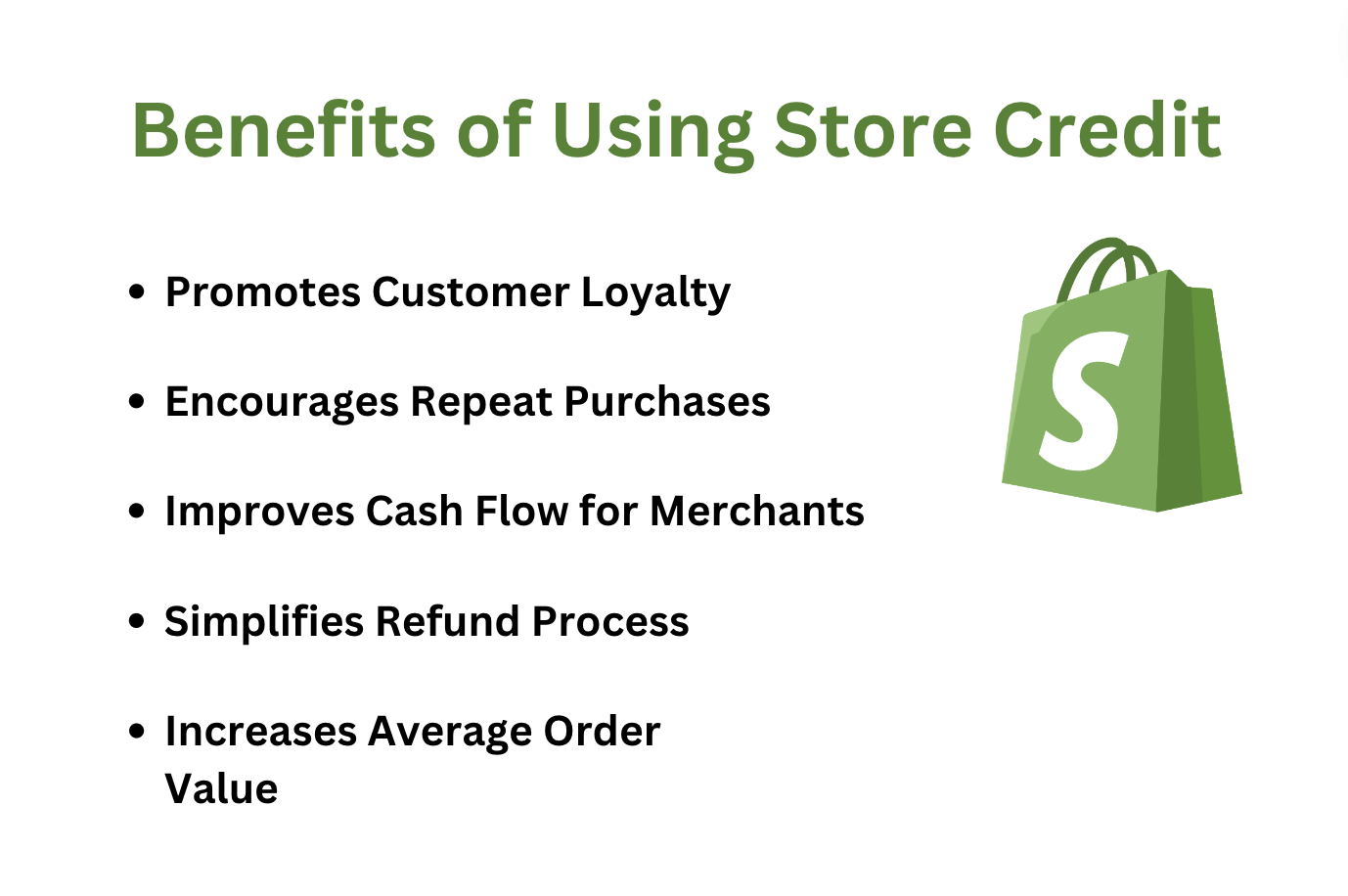
How to Set Up Store Credit in Shopify?
Many people might not be familiar with how to give store credit on Shopify. Here’s a step-by-step guide to help you get started.
Step 1: Access the Customers Section
- Log in to your Shopify admin panel.
- From the Shopify admin, click on Customers in the left-hand menu.
- Use the search bar or scroll through the list to find the customer you want to issue store credit to.
- Click on the customer’s name to open their profile.

Step 2: Edit Store Credit
- In the customer profile, locate the Store credit section. This section is usually found towards the middle or bottom of the profile page.
- Click the Edit button within the Store credit section.
- In the Adjustment section that appears, choose Credit to indicate you are adding store credit.
Step 3: Set Currency (Optional)
- If your store accepts multiple currencies, use the Currency drop-down menu to select the currency for the store credit.
- In the Amount field, enter the value of the store credit you wish to issue (e.g., $50).
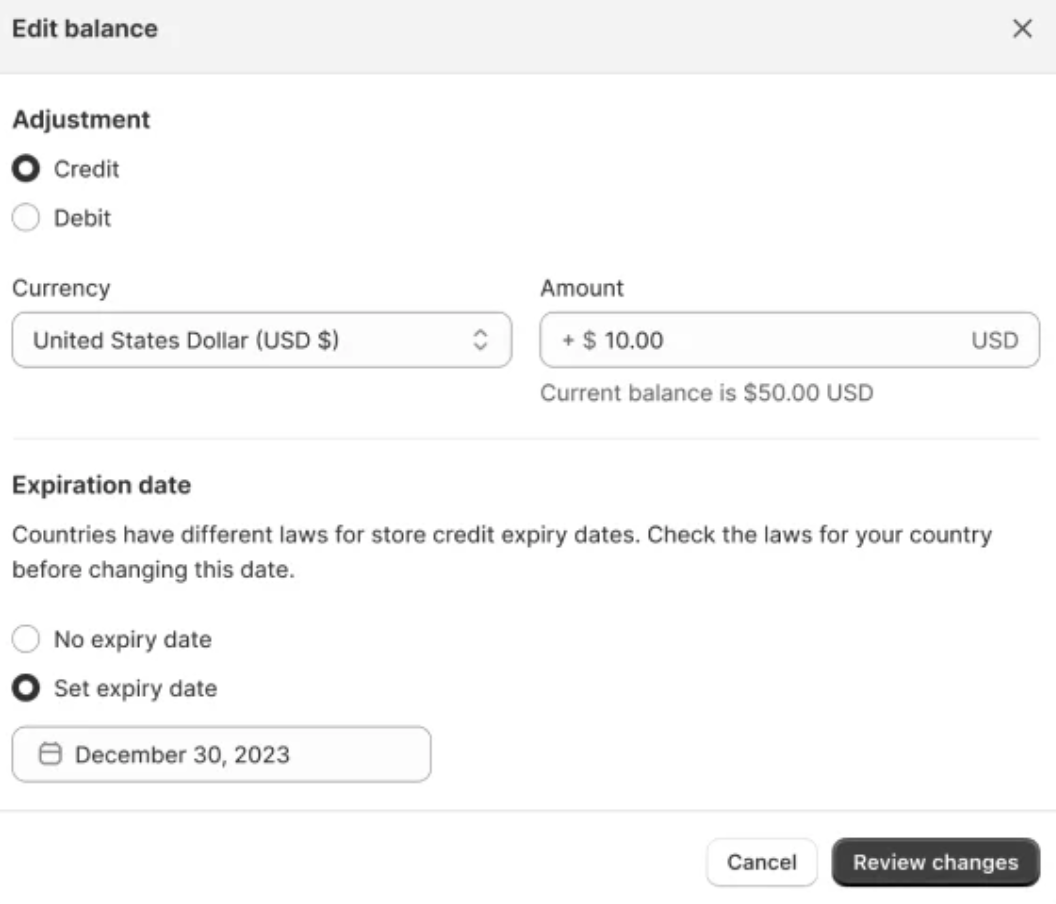
Step 4: Set Expiration Date (Optional)
If you want the store credit to never expire, select No expiry date.
To add an expiry date, select Set expiry date, and then choose a date from the calendar.

Step 5: Review and Confirm
- Click on Review changes to see a summary of the store credit details you have entered.
- Click on Credit [Amount] to issue the store credit to the customer.
Step 6: Verify Store Credit
After issuing the store credit, the customer’s store credit balance will increase in the Store credit section of their profile.
The issuance of store credit will also appear as an event in the customer’s timeline, providing a record of the transaction.
Several apps can provide direct store credit functionality, such as Returns Drive. These apps allow you to issue store credits directly to customer accounts without relying on discount codes or gift cards.
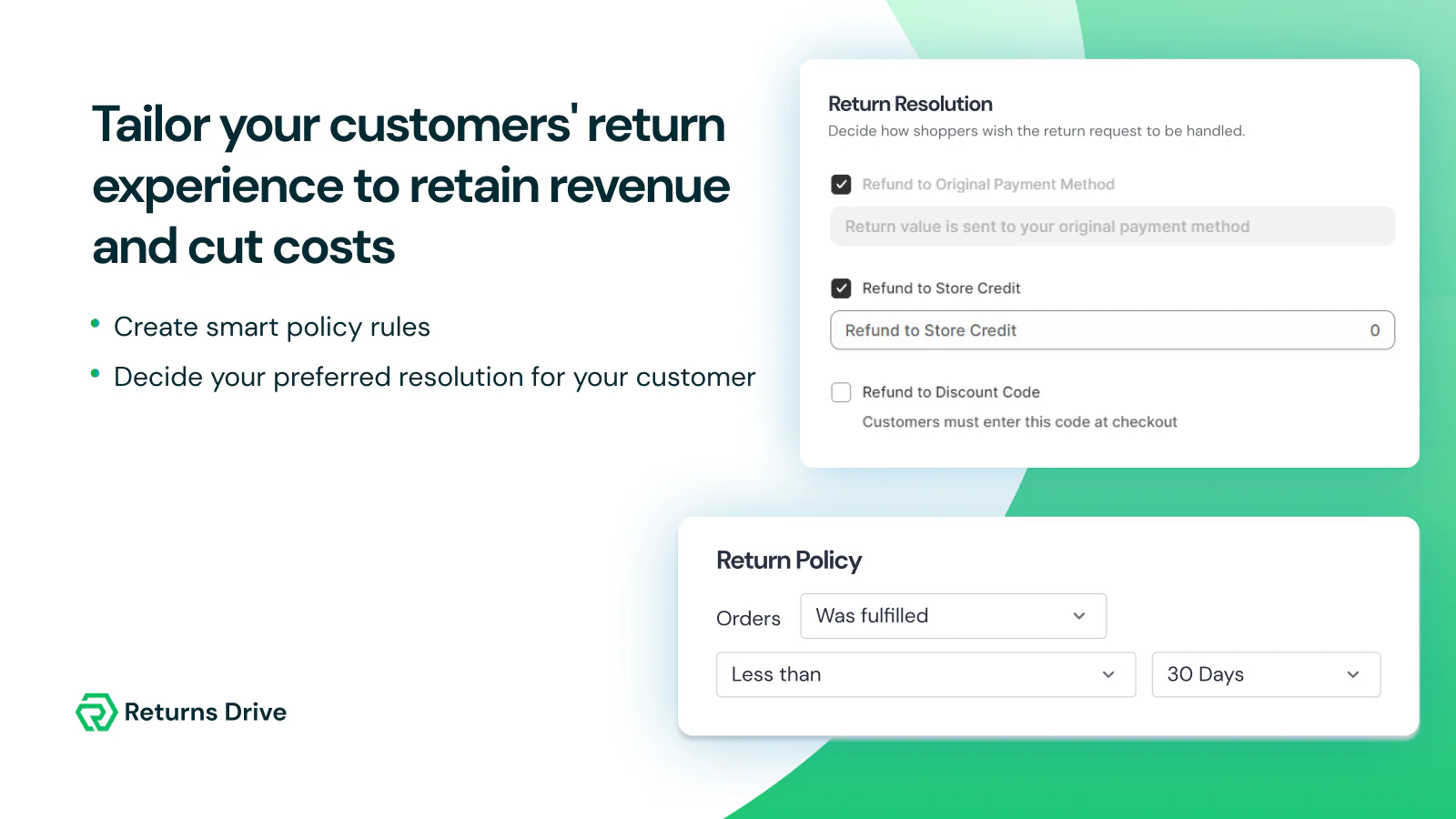
Best Practices for Using Store Credit on Shopify
Effectively managing store credit in your Shopify store is essential for retaining users and encouraging customer spending. You should consider these best practices:
#1 Maintain Accurate Records of Store Credits
Keep an organized log of issued store credits to monitor usage and prevent discrepancies. Use Shopify’s Sales Reports feature to track sales made with store credits or gift cards.
#2 Clearly Communicate with Customers
Provide clear instructions on how to redeem store credit on your website or via email notifications. This minimizes confusion and enhances customer satisfaction.
#3 Enhance Functionality with Apps
To improve the management of store credits, consider using apps that offer additional features such as automating rewards, managing balances, and providing detailed analytics. These apps can streamline the store credit process, making it easier for both you and your customers to handle credits effectively.
#4 Regularly Monitor Store Credit Usage
Analyze store data to identify trends in store credit usage, such as popular products and peak redemption times. This helps optimize marketing strategies and improve business performance.
Effectively managing store credit in Shopify can be challenging, but with the right tools and guidance, it becomes manageable. Addressing any arising issues is crucial for successful store management.
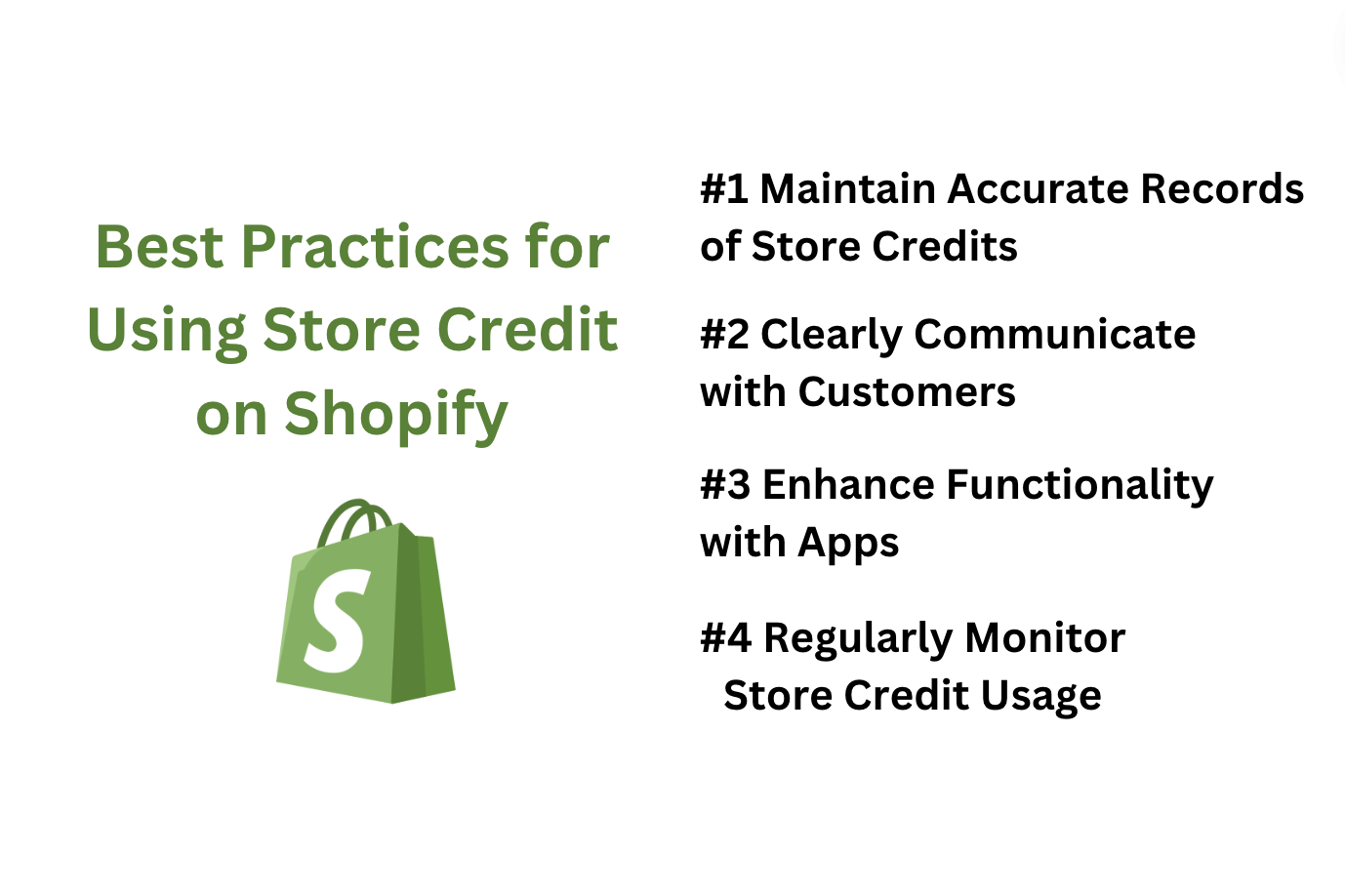
Shopify Store Credit Common Issues and Troubleshooting Tips
Managing store credit on Shopify can come with its challenges. Here are some common issues and troubleshooting tips to help you navigate them effectively.
1. Inaccurate Store Credit Balances
Store credit balances may not match the expected amounts due to manual errors, system glitches, or unauthorized adjustments. This can lead to confusion and mistrust among customers.
Troubleshooting: Regularly audit your store credit transactions using Shopify’s reporting tools to identify discrepancies. Ensure all manual adjustments are accurately recorded and implement a consistent process for issuing and redeeming store credits to minimize errors. If discrepancies are found, cross-check transactions with your financial records to pinpoint the source of the error.
2. Store Credit Not Applying at Checkout
Customers may be unable to apply their store credit during checkout, leading to frustration and potential loss of sales.
Troubleshooting: Verify that the store credit code is active and not expired. Ensure that the store credit rules allow it to be used with other discounts or promotions, and check that the minimum purchase requirements are met. Test the checkout process from a customer’s perspective to identify and resolve any bugs. If the problem persists, consult Shopify support or your third-party app provider.
3. Expired Store Credits
Customers may be unhappy with expired store credits, impacting customer satisfaction and loyalty.
Troubleshooting: Clearly communicate expiration dates to customers when issuing store credits. Send reminders before credits expire to encourage usage. Consider offering a grace period or reissuing the store credit as a goodwill gesture. Use automated email tools to notify customers about their credit status and upcoming expiration dates.
4. Store Credit Redemption Limits
Customers may face issues when the store credit they wish to redeem exceeds preset limits or conditions, causing dissatisfaction and potential loss of sales.
Troubleshooting: Clearly communicate any redemption limits or conditions to customers. Regularly review and adjust these limits to align with customer needs and business goals. Provide customers with flexible redemption options to enhance their shopping experience.
5. Store Credit Refund Conflicts
When issuing refunds, conflicts can arise between returning funds to the original payment method versus issuing store credit, leading to customer dissatisfaction.
Troubleshooting: Establish clear policies regarding refunds and store credit issuance. Communicate these policies effectively to customers during the purchase and refund processes. Offer customers a choice between receiving a refund to their original payment method or store credit to improve satisfaction.
Integrating Third-Party Apps to Improve the Store Credit Experience on Shopify
On Shopify, the store credit experience can be significantly enhanced by integrating third-party apps like Synctrack Returns & Exchanges. One notable feature of Synctrack Returns is its “refund to store credit” functionality. This feature allows store owners to issue refunds directly as store credit, streamlining the refund process and keeping the funds within the business.

The app’s “refund to store credit” feature allows retailers to issue refunds directly as store credit, which keeps funds within the store and encourages future purchases. Additionally, Synctrack Returns provides real-time updates on store credit balances, ensuring customers are always informed about their available credits. This transparency builds trust and encourages more frequent use of store credits, ultimately boosting customer retention and satisfaction.
Retaining Funds in the Store
The Synctrack Returns and Exchange app’s store credit refund feature helps retailers keep funds within the store. Instead of losing money through cash refunds, issuing store credit ensures that the funds remain in the business, supporting operational needs and future growth.
According to the app, businesses using store credit refunds retain up to 20% more revenue compared to those offering only cash refunds.
Real-Time Credit Balance Updates
The app offers real-time updates on store credit balances, allowing customers to check their available credits anytime. This instant information helps customers make informed purchasing decisions and plan future purchases effectively.
Synctrack data shows that 85% of customers check their store credit balance before making a purchase, leading to a higher conversion rate.
Increasing Customer Loyalty
By keeping funds in the store, driving repeat purchases, and providing transparent real-time updates, the Synctrack Returns and Exchange app significantly boosts customer loyalty. Satisfied customers who trust the refund process are more likely to become repeat buyers, contributing to long-term business success. According to Synctrack, businesses using their app see a 35% increase in customer loyalty metrics.
🛍️ Improve Customers' Experience by Providing an Easy-to-use Platform For Customers to Start Returns or Exchanges
How to Set up Store Credit in Synctrack Returns & Exchanges
First, let’s explore how Refund to Store Credit works. In the portal, you need to enable the option and set the amount. This allows customers to receive a bonus based on the subtotal. In the app, the bonus credit will be displayed in the management details.
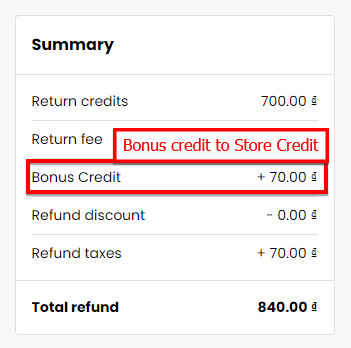
And now, here's how to enable Refund to Store Credit:
Step 1: Go to Refund Resolutions under Settings in the Synctrack Returns & Exchanges app.
Step 2: Enable Refund to Store Credit by shifting the toggle and add a brief description.
Step 3: Encourage customers by offering bonus credit, refunded via a gift card for their next order. To disable, set bonus credit to 0.
Step 4: Click Save.
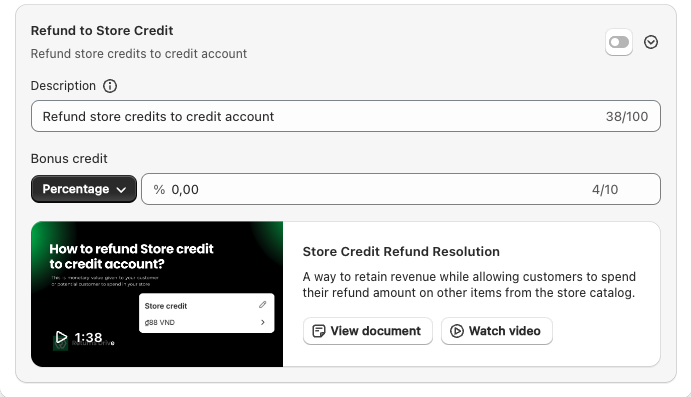
For more details about Setting up Store Credit, please read here.
Wrap up
In summary, knowing how to issue store credit on Shopify is vital for boosting customer satisfaction and retention. Implementing Shopify store credit effectively ensures a smooth shopping experience and encourages repeat purchases, benefiting both your business and customers.

